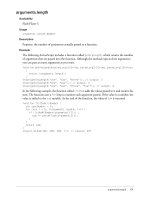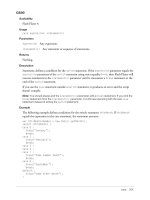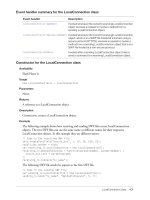Tài liệu Flash: ActionScript Language Reference- P4 ppt
Bạn đang xem bản rút gọn của tài liệu. Xem và tải ngay bản đầy đủ của tài liệu tại đây (344.79 KB, 100 trang )
for 301
for
Availability
Flash Player 5.
Usage
for(init; condition; next) {
statement(s);
}
Parameters
init
An expression to evaluate before beginning the looping sequence; usually an assignment
expression. A
var
statement is also permitted for this parameter.
condition
An expression that evaluates to
true
or
false
. The condition is evaluated before
each loop iteration; the loop exits when the condition evaluates to
false
.
next
An expression to evaluate after each loop iteration; usually an assignment expression using
the increment (
++)
or decrement (
--
) operators.
statement(s)
An instruction or instructions to execute within the body of the loop.
Description
Statement; evaluates the
init
(initialize) expression once and then starts a looping sequence. The
looping sequence begins by evaluating the
condition
expression. If the
condition
expression
evaluates to true,
statement
is executed and the
next
expression is evaluated. The looping
sequence then begins again with the evaluation of the
condition
expression.
The curly braces (
{}
) used to enclose the block of statements to be executed by the
for
statement
are not necessary if only one statement will execute.
Example
The following example uses
for
to add the elements in an array:
var my_array:Array = new Array();
for (var i:Number = 0; i<10; i++) {
my_array[i] = (i+5)*10;
//trace(my_array[i]);
}
trace(my_array); // output: 50,60,70,80,90,100,110,120,130,140
The following example uses
for
to perform the same action repeatedly. In the code, the
for
loop
adds the numbers from 1 to 100.
var sum:Number = 0;
for (var i:Number = 1; i<=100; i++) {
sum += i;
}
trace(sum); // output: 5050
CHAPTER 2
ActionScript Language Reference
302 Chapter 2: ActionScript Language Reference
The following example shows that curly braces ({}) are not necessary if only one statement will
execute:
var sum:Number = 0;
for (var i:Number = 1; i<=100; i++)
sum += i;
trace(sum); // output: 5050
See also
++ (increment), –– (decrement), for..in, var, while, do while
for..in 303
for..in
Availability
Flash Player 5.
Usage
for(variableIterant in object){
statement(s);
}
Parameters
variableIterant
The name of a variable to act as the iterant, referencing each property of an
object or element in an array.
object
The name of an object to be iterated.
statement(s)
An instruction to execute for each iteration.
Returns
Nothing.
Description
Statement; iterates over the properties of an object or elements in an array and executes the
statement
for each property or element. Methods of an object are not enumerated by the
for..in
action.
Some properties cannot be enumerated by the
for..in
action. For example, movie clip
properties, such as
_x
and
_y
, are not enumerated. In external class files, static members are not
enumerable, unlike instance members.
The
for..in
statement iterates over properties of objects in the iterated object’s prototype chain.
Properties of the object are enumerated first, then properties of its immediate prototype, then
properties of the prototype’s prototype, and so on. The
for..in
statement does not enumerate
the same property name twice. If the object
child
has prototype
parent
and both contain the
property
prop
, the
for..in
statement called on
child
enumerates
prop
from
child
but ignores
the one in
parent
.
The curly braces (
{}
) used to enclose the block of statements to be executed by the
for..in
statement are not necessary if only one statement will execute.
If you write a
for..in
loop in a class file (an external AS file), then instance members are not
available for the loop, but static members are. However, if you write a
for..in
loop in a FLA file
for an instance of the class, then instance members are available but static ones are not.
Examples
The following example shows using
for..in
to iterate over the properties of an object:
var myObject:Object = {name:"Tara", age:27, city:"San Francisco"};
for (var name in myObject) {
trace("myObject."+name+" = "+myObject[name]);
}
CHAPTER 2
ActionScript Language Reference
304 Chapter 2: ActionScript Language Reference
//output
myObject.name = Tara
myObject.age = 27
myObject.city = San Francisco
The following example shows using
for..in
to iterate over the elements of an array:
var myArray:Array = new Array("one", "two", "three");
for (var index in myArray)
trace("myArray["+index+"] = " + myArray[index]);
// output:
myArray[2] = three
myArray[1] = two
myArray[0] = one
The following example uses the
typeof
operator with
for..in
to iterate over a particular type of
child:
for (var name in this) {
if (typeof (this[name]) == "movieclip") {
trace("I have a movie clip child named "+name);
}
}
Note: If you have several movie clips, the output consists of the instance names of those clips.
The following example enumerates the children of a movie clip and sends each to Frame 2 in their
respective Timelines. The
RadioButtonGroup
movie clip is a parent with several children,
_RedRadioButton_
,
_GreenRadioButton_,
and
_BlueRadioButton
.
for (var name in RadioButtonGroup) {
RadioButtonGroup[name].gotoAndStop(2);
}
fscommand() 305
fscommand()
Availability
Flash Player 3.
Usage
fscommand("command", "parameters")
Parameters
command
A string passed to the host application for any use, or a command passed to
Flash Player.
parameters
A string passed to the host application for any use, or a value passed to
Flash Player.
Returns
Nothing.
Description
Function; lets the SWF file communicate with either Flash Player or the program hosting Flash
Player, such as a web browser. You can also use the
fscommand()
function to pass messages to
Macromedia Director, or to Visual Basic, Visual C++, and other programs that can host
ActiveX controls.
Usage 1: To send a message to Flash Player, you must use predefined commands and parameters.
The following table shows the values you can specify for the
command
and
parameters
parameters of the
fscommand()
function to control a SWF file playing in Flash Player,
including projectors.
Command Parameters Purpose
quit None
Closes the projector.
fullscreen
true
or
false
Specifying
true
sets Flash Player to full-screen mode.
Specifying
false
returns the player to normal menu view.
allowscale
true
or
false
Specifying
false
sets the player so that the SWF
file
is always
drawn at its original size and never scaled. Specifying
true
forces the SWF
file
to scale to 100% of the player.
showmenu
true
or
false
Specifying
true
enables the full set of context menu items.
Specifying
false
dims all the context menu items except About
Flash Player.
exec
Path to
application
Executes an application from within the projector.
trapallkeys
true
or
false
Specifying
true
sends all key events, including accelerator keys,
to the
onClipEvent(keyDown/keyUp)
handler in Flash Player.
CHAPTER 2
ActionScript Language Reference
306 Chapter 2: ActionScript Language Reference
The
exec
command can contain only the characters A–Z, a–z, 0–9, period (.), and underscore
(_). The
exec
command runs in the subdirectory fscommand only. In other words, if you use the
fscommand exec
command to call an application, the application must reside in a subdirectory
named fscommand.
Usage 2: To use the
fscommand()
function to send a message to a scripting language such as
JavaScript in a web browser, you can pass any two parameters in the
command
and
parameters
parameters. These parameters can be strings or expressions and are used in a JavaScript function
that handles, or catches, the
fscommand()
function.
In a web browser, the
fscommand()
function calls the JavaScript function
moviename_DoFScommand
in the HTML page containing the SWF file. The
moviename
is the
name of the Flash Player as assigned by the
NAME
attribute of the
EMBED
tag or the ID property of
the
OBJECT
tag. If you assign the Flash Player the name
myDocument
, the JavaScript function
called is
myDocument_DoFScommand
.
Usage 3: The
fscommand()
function can send messages to Macromedia Director that are
interpreted by Lingo (Director’s scripting language) as strings, events, or executable Lingo code. If
the message is a string or an event, you must write the Lingo code to receive the message from the
fscommand()
function and carry out an action in Director. For more information, see the
Director Support Center at www.macromedia.com/support/director.
Usage 4: In Visual Basic, Visual C++, and other programs that can host ActiveX controls, the
fscommand()
function sends a VB event with two strings that can be handled in
the environment’s programming language. For more information, use the keywords Flash method
to search the Flash Support Center at www.macromedia.com/support/flash.
Example
In the following example, the
fscommand()
function sets Flash Player to scale the SWF file to the
full monitor screen size when the
fullscreen_btn
button or
unfullscreen_btn
is released:
this.fullscreen_btn.onRelease = function() {
fscommand("fullscreen", true);
};
this.unfullscreen_btn.onRelease = function() {
fscommand("fullscreen", false);
};
The following example uses the
fscommand()
function applied to a button in Flash to open a
JavaScript message box in an HTML page. The message itself is sent to JavaScript as the
fscommand
parameter.
You must add a function to the HTML page that contains the SWF file. This function,
myDocument_DoFSCommand
, sits in the HTML page and waits for an
fscommand()
function in
Flash. When an
fscommand
is triggered in Flash (for example, when a user presses the button), the
command
and
parameter
strings are passed to the
myDocument_DoFSCommand
function. You can
use the passed strings in your JavaScript or VBScript code in any way you like. In this example,
the function contains a conditional
if
statement that checks to see if the command string is
"messagebox"
. If it is, a JavaScript alert box (or “message box”) opens and displays the contents
of the
parameters
string.
fscommand() 307
function myDocument_DoFSCommand(command, args) {
if (command == "messagebox") {
alert(args);
}
}
In the Flash document, add the
fscommand()
function to a button:
fscommand("messagebox", "This is a message box called from within Flash.")
You can also use expressions for the
fscommand()
function and parameters, as in the
following example:
fscommand("messagebox", "Hello, " + name + ", welcome to our website!")
To test the SWF file, select File > Publish Preview > HTML.
Note: If you publish your SWF file using the Flash with FSCommand template in the HTML tab of the
Publish Settings dialog box, the
myDocument_DoFSCommand
function is inserted automatically. The
SWF file’s
NAME
and
ID
attributes will be the filename. For example, for the file myDocument.fla, the
attributes would be set to
myDocument
.
308 Chapter 2: ActionScript Language Reference
function
Availability
Flash Player 5.
Usage
function functionname ([parameter0, parameter1,...parameterN]){
statement(s)
}
function ([parameter0, parameter1,...parameterN]){
statement(s)
}
Parameters
functionname
The name of the new function. This parameter is optional.
parameter
An identifier that represents a parameter to pass to the function. This parameter is
optional.
statement(s)
Any ActionScript instruction you have defined for the body of the
function
.
Returns
Usage 1: Nothing.
Usage 2: A reference to the anonymous function.
Description
Statement; comprises a set of statements that you define to perform a certain task. You can define
a function in one location and invoke, or call, it from different scripts in a SWF file. When you
define a function, you can also specify parameters for the function. Parameters are placeholders
for values on which the function operates. You can pass different parameters to a function each
time you call it so you can reuse a function in different situations.
Use the
return
statement in a function’s
statement(s)
to cause a function to generate, or return,
a value.
You can use this statement to define a
function
with the specified
functionname
,
parameters
,
and
statement(s)
. When a script calls a function, the statements in the function’s definition are
executed. Forward referencing is permitted; within the same script, a function may be declared
after it is called. A function definition replaces any prior definition of the same function. You can
use this syntax wherever a statement is permitted.
You can also use this statement to create an anonymous function and return a reference to it. This
syntax is used in expressions and is particularly useful for installing methods in objects.
For additional functionality, you can use the
arguments object
in your function definition.
Some common uses of the
arguments object
are creating a function that accepts a variable
number of parameters and creating a recursive anonymous function.
CHAPTER 2
ActionScript Language Reference
function 309
Example
The following example defines the function
sqr
, which accepts one parameter and returns the
Math.pow(x, 2)
of the parameter:
function sqr(x:Number) {
return Math.pow(x, 2);
}
var y:Number = sqr(3);
trace(y); // output: 9
If the function is defined and used in the same script, the function definition may appear after
using the function:
var y:Number = sqr(3);
trace(y); // output: 9
function sqr(x:Number) {
return Math.pow(x, 2);
}
The following function creates a LoadVars object and loads params.txt into the SWF file. When
the file successfully loads,
variables loaded
traces:
var myLV:LoadVars = new LoadVars();
myLV.load("params.txt");
myLV.onLoad = function(success:Boolean) {
trace("variables loaded");
}
310 Chapter 2: ActionScript Language Reference
Function class
Availability
Flash Player 6.
Description
Both user-defined and built-in functions in ActionScript are represented by Function objects,
which are instances of the Function class.
Method summary for the Function class
Method Description
Function.apply()
Invokes the function represented by a Function object, with parameters
passed in through an array.
Function.call()
Invokes the function represented by a Function object.
CHAPTER 2
ActionScript Language Reference
Function.apply() 311
Function.apply()
Availability
Flash Player 6.
Usage
myFunction.apply(thisObject:Object, argumentsArray:Array)
Parameters
thisObject
The object to which
myFunction
is applied.
argumentsArray
An array whose elements are passed to
myFunction
as parameters.
Returns
Any value that the called function specifies.
Description
Method; specifies the value of
this
to be used within any function that ActionScript calls. This
method also specifies the parameters to be passed to any called function. Because
apply()
is a
method of the Function class, it is also a method of every Function object in ActionScript.
The parameters are specified as an Array object, unlike Function.call(), which specifies parameters
as a comma-delimited list. This is often useful when the number of parameters to be passed is not
known until the script actually executes.
Example
The following function invocations are equivalent:
Math.atan2(1, 0)
Math.atan2.apply(null, [1, 0])
The following simple example shows how
apply()
passes an array of parameters:
function theFunction() {
trace(arguments);
}
// create a new array to pass as a parameter to apply()
var firstArray:Array = new Array(1,2,3);
theFunction.apply(null,firstArray);
// outputs: 1,2,3
// create a second array to pass as a parameter to apply()
var secondArray:Array = new Array("a", "b", "c");
theFunction.apply(null,secondArray);
// outputs a,b,c
The following example shows how
apply()
passes an array of parameters and specifies the value
of
this
:
// define a function
function theFunction() {
312 Chapter 2: ActionScript Language Reference
trace("this == myObj? " + (this == myObj));
trace("arguments: " + arguments);
}
// instantiate an object
var myObj:Object = new Object();
// create arrays to pass as a parameter to apply()
var firstArray:Array = new Array(1,2,3);
var secondArray:Array = new Array("a", "b", "c");
// use apply() to set the value of this to be myObj and send firstArray
theFunction.apply(myObj,firstArray);
// output:
// this == myObj? true
// arguments: 1,2,3
// use apply() to set the value of this to be myObj and send secondArray
theFunction.apply(myObj,secondArray);
// output:
// this == myObj? true
// arguments: a,b,c
See also
Function.call()
Function.call() 313
Function.call()
Availability
Flash Player 6.
Usage
myFunction.call(thisObject:Object, parameter1, ..., parameterN)
Parameters
thisObject
An object that specifies the value of
this
within the function body.
parameter1
A parameter to be passed to the
myFunction
. You can specify zero or
more parameters.
parameterN
Returns
Nothing.
Description
Method; invokes the function represented by a Function object. Every function in ActionScript is
represented by a Function object, so all functions support this method.
In almost all cases, the function call (
()
) operator can be used instead of this method. The
function call operator produces code that is concise and readable. This method is primarily useful
when the
this
parameter of the function invocation needs to be explicitly controlled. Normally,
if a function is invoked as a method of an object, within the body of the function,
this
is set to
myObject,
as shown in the following example:
myObject.myMethod(1, 2, 3);
In some situations, you might want
this
to point somewhere else; for example, if a function must
be invoked as a method of an object, but is not actually stored as a method of that object:
myObject.myMethod.call(myOtherObject, 1, 2, 3);
You can pass the value
null
for the
thisObject
parameter to invoke a function as a regular
function and not as a method of an object. For example, the following function invocations
are equivalent:
Math.sin(Math.PI / 4)
Math.sin.call(null, Math.PI / 4)
Example
The following example uses
Function.call()
to make a function behave as a method of another
object, without storing the function in the object:
function myObject() {
}
function myMethod(obj) {
trace("this == obj? " + (this == obj));
}
314 Chapter 2: ActionScript Language Reference
var obj:Object = new myObject();
myMethod.call(obj, obj);
The
trace()
statement displays:
this == obj? true
See also
Function.apply()
get 315
get
Availability
Flash Player 6.
Usage
function get property() {
// your statements here
}
Note: To use this keyword, you must specify ActionScript 2.0 and Flash Player 6 or later in the Flash
tab of your FLA file’s Publish Settings dialog box. This keyword is supported only when used in
external script files, not in scripts written in the Actions panel.
Parameters
property
The word you use to refer to the property that
get
accesses; this value must be the
same as the value used in the corresponding
set
command.
Returns
Nothing.
Description
Keyword; permits implicit getting of properties associated with objects based on classes you have
defined in external class files. Using implicit get methods lets you access properties of objects
without accessing the property directly. Implicit get/set methods are syntactic shorthand for the
Object.addProperty()
method in ActionScript 1.
For more information, see “Implicit getter/setter methods” in Using ActionScript in Flash.
Example
In the following example, you define a Team class. The Team class includes get/set methods that
let you retrieve and set properties within the class:
class Team {
var teamName:String;
var teamCode:String;
var teamPlayers:Array = new Array();
function Team(param_name:String, param_code:String) {
this.teamName = param_name;
this.teamCode = param_code;
}
function get name():String {
return this.teamName;
}
function set name(param_name:String):Void {
this.teamName = param_name;
}
}
CHAPTER 2
ActionScript Language Reference
316 Chapter 2: ActionScript Language Reference
Enter the following ActionScript in a frame on the Timeline:
var giants:Team = new Team("San Fran", "SFO");
trace(giants.name);
giants.name = "San Francisco";
trace(giants.name);
/* output:
San Fran
San Francisco
*/
When you trace giants.name, you use the get method to return the value of the property.
See also
Object.addProperty(), set
getProperty() 317
getProperty()
Availability
Flash Player 4.
Usage
getProperty(my_mc:Object, property:Object) : Object
Parameters
my_mc
The instance name of a movie clip for which the property is being retrieved.
property
A property of a movie clip.
Returns
The value of the specified property.
Description
Function; returns the value of the specified property for the movie clip
my_mc
.
Example
The following example creates a new movie clip
someClip_mc
and shows the alpha value
(
_alpha
) for the movie clip
someClip_mc
in the Output panel:
this.createEmptyMovieClip("someClip_mc", 999);
trace("The alpha of "+getProperty(someClip_mc, _name)+" is:
"+getProperty(someClip_mc, _alpha));
CHAPTER 2
ActionScript Language Reference
318 Chapter 2: ActionScript Language Reference
getTimer()
Availability
Flash Player 4.
Usage
getTimer() : Number
Parameters
None.
Returns
The number of milliseconds that have elapsed since the SWF file started playing.
Description
Function; returns the number of milliseconds that have elapsed since the SWF file started playing.
Example
In the following example, the
getTimer()
and
setInterval()
functions are used to create a
simple timer:
this.createTextField("timer_txt", this.getNextHighestDepth(), 0, 0, 100, 22);
function updateTimer():Void {
timer_txt.text = getTimer();
}
var intervalID:Number = setInterval(updateTimer, 100);
CHAPTER 2
ActionScript Language Reference
getURL() 319
getURL()
Availability
Flash 2. The
GET
and
POST
options are available only in Flash Player 4 and later versions.
Usage
getURL(url:String [, window:String [, "variables":String]]) : Void
Parameters
url
The URL from which to obtain the document.
window
An optional parameter specifying the window or HTML frame into which the
document should load. You can enter the name of a specific window or select from the following
reserved target names:
•
_self
specifies the current frame in the current window.
•
_blank
specifies a new window.
•
_parent
specifies the parent of the current frame.
•
_top
specifies the top-level frame in the current window.
variables
A
GET
or
POST
method for sending variables. If there are no variables, omit this
parameter. The
GET
method appends the variables to the end of the URL, and is used for small
numbers of variables. The
POST
method sends the variables in a separate HTTP header and is
used for sending long strings of variables.
Returns
Nothing.
Description
Function; loads a document from a specific URL into a window or passes variables to another
application at a defined URL. To test this function, make sure the file to be loaded is at the
specified location. To use an absolute URL (for example,
), you need
a network connection.
Example
This example loads an image into a movie clip. When the image is clicked, a new URL is loaded
in a new browser window.
var listenerObject:Object = new Object();
listenerObject.onLoadInit = function(target_mc:MovieClip) {
target_mc.onRelease = function() {
getURL(" "_blank");
};
};
var logo:MovieClipLoader = new MovieClipLoader();
logo.addListener(listenerObject);
logo.loadClip(" />159x120_box_flashpro.jpg", this.createEmptyMovieClip("macromedia_mc",
this.getNextHighestDepth()));
CHAPTER 2
ActionScript Language Reference
320 Chapter 2: ActionScript Language Reference
In the following example,
getURL()
is used to send an e-mail message:
myBtn_btn.onRelease = function(){
getURL("mailto:");
};
In the following ActionScript, JavaScript is used to open an alert window when the SWF file is
embedded in a browser window:
myBtn_btn.onRelease = function(){
getURL("javascript:alert('you clicked me')");
};
You can also use
GET
or
POST
for sending variables. The following example uses
GET
to append
variables to a URL:
var firstName:String = "Gus";
var lastName:String = "Richardson";
var age:Number = 92;
myBtn_btn.onRelease = function() {
getURL("", "_blank", "GET");
};
The following ActionScript uses
POST
to send variables in the HTTP header. Make sure you test
your documents in a browser window, because otherwise your variables are sent using
GET
:
var firstName:String = "Gus";
var lastName:String = "Richardson";
var age:Number = 92;
getURL("", "_blank", "POST");
See also
loadVariables(), XML.send(), XML.sendAndLoad(), XMLSocket.send()
getVersion() 321
getVersion()
Availability
Flash Player 5.
Usage
getVersion() : String
Parameters
None.
Returns
A string containing Flash Player version and platform information.
Description
Function; returns a string containing Flash Player version and platform information.
The
getVersion
function returns information only for Flash Player 5 or later versions of
Flash Player.
Example
The following examples trace the version number of the Flash Player playing the SWF file:
var flashVersion:String = getVersion();
trace(flashVersion); // output: WIN 7,0,19,0
trace($version); // output: WIN 7,0,19,0
trace(System.capabilities.version); // output: WIN 7,0,19,0
The following string is returned by the
getVersion
function:
WIN 7,0,19,0
This returned string indicates that the platform is Microsoft Windows, and the version number of
Flash Player is major version 7, minor version 19 (7.19).
See also
System.capabilities.os, System.capabilities.version
CHAPTER 2
ActionScript Language Reference
322 Chapter 2: ActionScript Language Reference
_global object
Availability
Flash Player 6.
Usage
_global.identifier
Parameters
None.
Returns
A reference to the global object that holds the core ActionScript classes, such as String, Object,
Math, and Array.
Description
Identifier; creates global variables, objects, or classes. For example, you could create a library that
is exposed as a global ActionScript object, similar to the Math or Date object. Unlike Timeline-
declared or locally declared variables and functions, global variables and functions are visible to
every Timeline and scope in the SWF file, provided they are not obscured by identifiers with the
same names in inner scopes.
Example
The following example creates a top-level function,
factorial(),
that is available to every
Timeline and scope in a SWF file:
_global.factorial = function(n:Number) {
if (n<=1) {
return 1;
} else {
return n*factorial(n-1);
}
};
// Note: factorial 4 == 4*3*2*1 == 24
trace(factorial(4)); // output: 24
See also
var, set variable
CHAPTER 2
ActionScript Language Reference
gotoAndPlay() 323
gotoAndPlay()
Availability
Flash 2.
Usage
gotoAndPlay([scene:String,] frame:Object) : Void
Parameters
scene
An optional string specifying the name of the scene to which the playhead is sent.
frame
A number representing the frame number, or a string representing the label of the frame,
to which the playhead is sent.
Returns
Nothing.
Description
Function; sends the playhead to the specified frame in a scene and plays from that frame. If no
scene is specified, the playhead goes to the specified frame in the current scene.
You can use the
scene
parameter only on the root Timeline, not within Timelines for movie clips
or other objects in the document.
Example
In the following example, a document has two scenes:
sceneOne
and
sceneTwo
. Scene one
contains a frame label on Frame 10 called
newFrame
and two buttons,
myBtn_btn
and
myOtherBtn_btn
. This ActionScript is placed on Frame 1, Scene 1 of the main Timeline.
stop();
myBtn_btn.onRelease = function(){
gotoAndPlay("newFrame");
};
myOtherBtn_btn.onRelease = function(){
gotoAndPlay("sceneTwo", 1);
};
When the user clicks the buttons, the playhead moves to the specified location and continues
playing.
See also
MovieClip.gotoAndPlay(), play(), nextFrame(), prevFrame()
CHAPTER 2
ActionScript Language Reference
324 Chapter 2: ActionScript Language Reference
gotoAndStop()
Availability
Flash 2.
Usage
gotoAndStop([scene:String,] frame:Object) : Void
Parameters
scene
An optional string specifying the name of the scene to which the playhead is sent.
frame
A number representing the frame number, or a string representing the label of the frame,
to which the playhead is sent.
Returns
Nothing.
Description
Function; sends the playhead to the specified frame in a scene and stops it. If no scene is specified,
the playhead is sent to the frame in the current scene.
You can use the
scene
parameter only on the root Timeline, not within Timelines for movie clips
or other objects in the document.
Example
In the following example, a document has two scenes:
sceneOne
and
sceneTwo
. Scene one
contains a frame label on Frame 10 called
newFrame
, and two buttons,
myBtn_btn
and
myOtherBtn_btn
. This ActionScript is placed on Frame 1, Scene 1 of the main Timeline:
stop();
myBtn_btn.onRelease = function(){
gotoAndStop("newFrame");
};
myOtherBtn_btn.onRelease = function(){
gotoAndStop("sceneTwo", 1);
};
When the user clicks the buttons, the playhead moves to the specified location and stops.
See also
MovieClip.gotoAndStop(), stop(), play(), gotoAndPlay()
CHAPTER 2
ActionScript Language Reference
if 325
if
Availability
Flash Player 4.
Usage
if(condition) {
statement(s);
}
Parameters
condition
An expression that evaluates to
true
or
false
.
statement(s)
The instructions to execute if or when the condition evaluates to
true
.
Returns
Nothing.
Description
Statement; evaluates a condition to determine the next action in a SWF file. If the condition is
true
, Flash runs the statements that follow the condition inside curly braces (
{}
). If the condition
is
false
, Flash skips the statements inside the curly braces and runs the statements following the
curly braces. Use the
if
statement along with the
else
and
else if
statements to create
branching logic in your scripts.
The curly braces (
{}
) used to enclose the block of statements to be executed by the
if
statement
are not necessary if only one statement will execute.
Example
In the following example, the condition inside the parentheses evaluates the variable
name
to see if
it has the literal value
“Erica”
. If it does, the
play()
function inside the curly braces runs.
if(name == "Erica"){
play();
}
The following example uses an
if
statement to evaluate how long it takes a user to click the
submit_btn
instance in a SWF file. If a user clicks the button more than 10 seconds after the
SWF file plays, the condition evaluates to
true
and the message inside the curly braces (
{}
)
appears in a text field that’s created at runtime (using
createTextField()
). If the user clicks the
button less than 10 seconds after the SWF file plays, the condition evaluates to
false
and a
different message appears.
this.createTextField("message_txt", this.getNextHighestDepth, 0, 0, 100, 22);
message_txt.autoSize = true;
var startTime:Number = getTimer();
this.submit_btn.onRelease = function() {
var difference:Number = (getTimer()-startTime)/1000;
if (difference>10) {
this._parent.message_txt.text = "Not very speedy, you took "+difference+"
seconds.";
CHAPTER 2
ActionScript Language Reference









